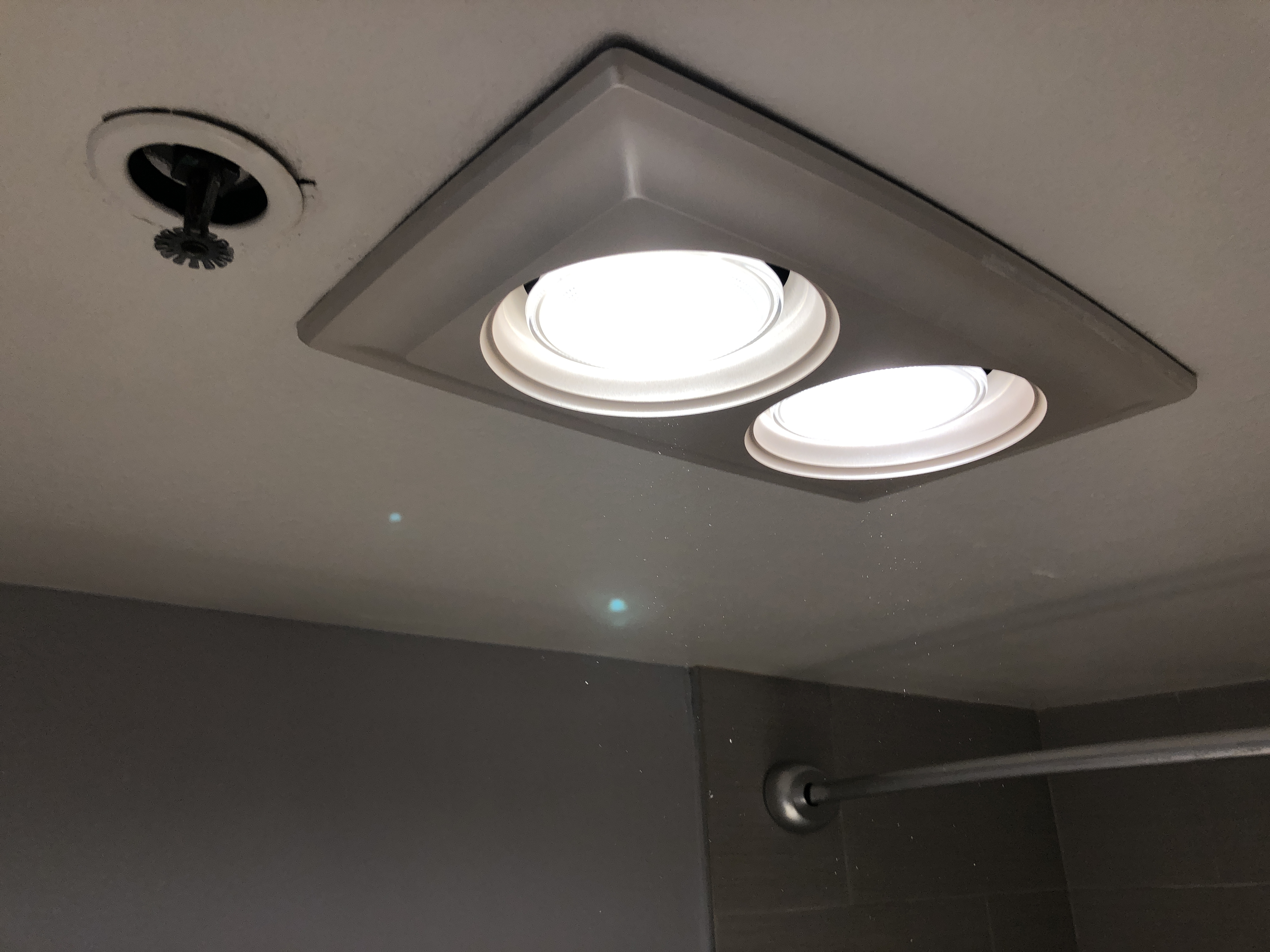1. Purchase a heat lamp specifically designed for bathroom use.
2. Read the manufacturer’s instructions carefully before attempting to install the heat lamp.
3. Most models of heat lamps are designed to be installed using two screws; however, some may require three screws for stability.
4. Use a drill to create pilot holes in the ceiling where you will be screwing in the heat lamp.
5. Insert the screws into the pilot holes and tighten them until the heat lamp is secure.
6. Be sure to attach any necessary wires or cords per the manufacturer’s instructions before turning on your new heat lamp!
- Choose a location for the heat lamp
- The heat lamp should be installed near the center of the bathroom, at least 4 feet above the floor
- Mark the location of the heat lamp on the ceiling with a pencil
- Cut a hole in the ceiling at the marked location using a hole saw or other suitable tool
- Install a junction box at the hole in the ceiling and connect it to an electrical circuit
- 5 Hang the heat lamp fixture from the junction box and screw it into place
- 6 Install any bulbs required by screwing them into place in the socket of the fixture
Can I Put a Heat Lamp in My Bathroom?
You can put a heat lamp in your bathroom, but there are a few things you need to keep in mind. First, make sure the heat lamp is rated for bathrooms. Second, be sure to install it properly so that it is safe and won’t start a fire.
Here are a few tips for choosing and installing a heat lamp in your bathroom:
1. Choose a heat lamp that is specifically designed for use in bathrooms. These lamps are usually labeled as “bathroom-safe” or something similar.
2. Make sure the heat lamp you choose can be properly installed in your bathroom. Some models must be hardwired by an electrician, while others can be simply plugged into an outlet.
3. Be sure to read all of the instructions that come with your heat lamp before installation.
This will help ensure that you install it correctly and safely.
4. Install the heat lamp according to the manufacturer’s instructions. This usually involves mounting the fixture to the ceiling or wall using screws or brackets provided with the unit.
5. Connect the power source to the heat lamp according to the manufacturer’s instructions (usually via wiring). Once everything is properly connected, turn on the power switch and test out your new heat lamp!
Does a Bathroom Heat Lamp Need Its Own Circuit?
Most homes have a single circuit that runs through the main living areas and powers all of the outlets. This is typically called the “general purpose” or “standard” circuit. Bathroom heat lamps generally need their own dedicated circuit, which is separate from the standard circuit.
This is because bathroom heat lamps draw a lot of power and can overload the standard circuit.
How Do You Heat an Unheated Bathroom?
Most people don’t think about how they will heat an unheated bathroom until they need to use one. An unheated bathroom can be very cold and uncomfortable, so it’s important to know how to properly heat it before you find yourself in that situation.
There are a few different ways that you can heat an unheated bathroom.
The most common way is to use a space heater. Space heaters are small, portable devices that generate heat and can easily be placed in an unheated room. Another option is to use a floor mat heater.
Floor mat heaters are mats that plug into an outlet and emit radiant heat, warming up the area around them.
If you don’t have access to a space heater or floor mat heater, you can try using a hairdryer to generate some warmth. Simply turn on the hairdryer and point it towards the coldest part of the room for a few minutes.
You can also boil water on the stovetop and pour it into a bowl or pot placed in the room (be careful not to burn yourself!). The steam from the boiling water will help warm up the air in the room.
Whatever method you choose, make sure that you close any doors leading into the bathroom so that all of the heat stays inside.
Once the room is warmed up, enjoy your time in the now comfortable space!
Can You Put a Heat Lamp in a Recessed Light Fixture?
If you’re considering adding a heat lamp to your recessed light fixture, there are a few things you need to take into account. First, make sure the recessed light fixture is rated for use with an incandescent bulb – not all fixtures are. Second, because heat lamps give off quite a bit of heat, be sure the fixture is installed in an area where it won’t overheat anything else (like insulation).
Finally, make sure the wiring is up to code and can handle the additional load of the heat lamp. If everything checks out, then go ahead and enjoy your cozy new spot!

Credit: www.hunker.com
Bathroom Heat Lamp Without Fan
Bathroom heat lamps are a great way to keep your bathroom warm without having to use a fan. They work by using a bulb to produce heat, which is then directed into the room. Bathroom heat lamps are available in a variety of sizes and styles, so you can find one that fits your needs.
Here are some things to keep in mind when choosing a bathroom heat lamp:
-Size: Bathroom heat lamps come in all different sizes. You’ll want to choose one that is large enough to provide adequate coverage for your space.
-Style: There are many different styles of bathroom heat lamps available on the market. You can choose from traditional incandescent bulbs, LED bulbs, or even infrared bulbs. Each type has its own set of benefits and drawbacks, so be sure to do your research before making a decision.
-Price: Bathroom heat lamps range in price from around $20-$100. Again, it’s important to consider the size and style of the unit when making your decision.
Heat Lamp for Bathroom Ceiling
Whether you’re taking a long, hot shower or just trying to keep your bathroom warm on a cold winter night, a heat lamp is a great way to add some extra warmth. Heat lamps are also ideal for people with certain medical conditions that make them sensitive to cold temperatures.
There are several different types of heat lamps available on the market, but most bathroom heat lamps fall into one of two categories: infrared or incandescent.
Infrared heat lamps emit invisible infrared waves that penetrate the skin and provide deep, penetrating heat. Incandescent heat lamps, on the other hand, use a filament that glows when heated by an electric current. This type of lamp emits visible light as well as heat, so it’s best suited for bathrooms that don’t have any natural light source.
When choosing a bathroom heat lamp, there are several factors to consider. The first is the size of your bathroom. If you have a small bathroom, you’ll want to choose a smaller heat lamp so it doesn’t take up too much space.
You should also consider how much power you need; most household circuits can handle up to 1500 watts without issue, but if you need more power than that, you may need to install a dedicated circuit just for your heat lamp.
Finally, think about what style of light fixture will work best in your bathroom. If you want something that blends in with your existing décor, look for an attractive wall-mounted fixture or recessed lighting unit designed specifically for use with infrared or incandescent bulbs.
On the other hand, if you don’t mind drawing attention to your heat lamp (or if you want it to double as a nightlight), go for a ceiling-mounted unit with an exposed bulb.
Are Bathroom Heat Lamps Safe
Are Bathroom Heat Lamps Safe?
Most people don’t give much thought to their bathroom heat lamps. But are they really safe?
Let’s take a closer look.
Bathroom heat lamps are usually found in the ceiling, and they provide gentle warmth to the room. They’re often used in conjunction with a timer, so that they’ll turn on automatically when you need them, and turn off after a set amount of time.
There are two main types of bathroom heat lamps: infrared and incandescent. Infrared heat lamps emit invisible infrared radiation, which is absorbed by your skin and turns into heat. Incandescent heat lamps work differently – they use electricity to heat up a metal filament inside the bulb, which then emits visible light as well as infrared radiation.
So, what’s the big deal with infrared radiation? Well, it’s been linked to cancer in high doses. However, the amount of infrared radiation emitted by bathroom heat lamps is very low, and it’s not considered harmful to human health.
Incandescent bulbs also emit small amounts of ultraviolet (UV) radiation. UV radiation can damage your skin and eyes if you’re exposed to it for too long. However, most bathroom heat lamps have special filters that block out most of the UV rays before they reach you.
So as long as you don’t stare directly at the bulb for extended periods of time, you should be fine.
In general, bathroom heat lamps are safe for most people to use. Just be sure to follow the manufacturer’s instructions carefully, and don’t stare directly at the bulb for prolonged periods of time!
Conclusion
If you’re planning on adding a heat lamp to your bathroom, there are a few things you need to keep in mind. First, you’ll need to choose a location for the heat lamp. It’s important to make sure that the area is well-ventilated and that the heat lamp is out of reach of any water sources.
Once you’ve found the perfect spot, you’ll need to install a light fixture that can accommodate a heat bulb. To do this, simply remove the existing light bulb from the fixture and screw in the heat bulb in its place. Be sure to follow all manufacturer instructions when doing this.
Finally, turn on the power to the fixture and enjoy your new heat lamp!
